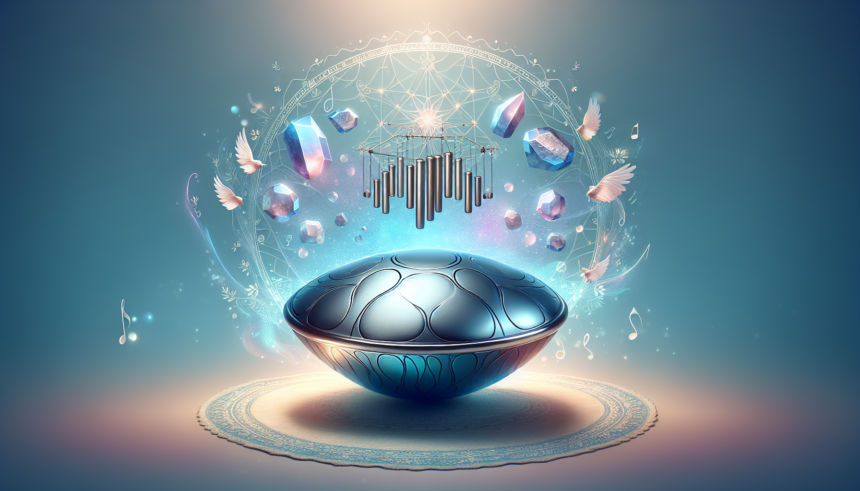The world of vibrational therapy is as fascinating as it is ancient, with roots extending back to the dawn of human civilization. Within this realm, the handpan has emerged as a particularly enchanting and effective tool. This beautiful, spaceship-like percussion instrument hasn’t just captured the imagination of musicians; it has also garnered interest among therapists and healers for its unique ability to influence physical and emotional well-being through vibrational frequencies. In this article, we will delve into the characteristics of the handpan that make it so special, explore its various applications in vibrational therapy, and provide a detailed look into the science behind its healing effects.
The Handpan: An Overview
The handpan, also known as the hang drum or pantam, was first introduced in the early 2000s by Swiss musicians Felix Rohner and Sabina Schärer. The instrument is typically made from two half-shells of nitrided steel that are glued together, forming a hollow center with a series of tonal fields or dimples hammered into the top half. When these fields are struck by hand, they produce a range of harmonic sounds that are both mesmerizing and soothing.
Key Characteristics
The handpan operates on the principle of sympathetic resonance, where one vibrating object can cause another to vibrate in harmony. The instrument’s tonal fields are tuned to specific frequencies, often harmonized to form a complete scale or a particular mode. Because of this meticulous tuning, a handpan can create complex, layered soundscapes that resonate deeply with the listener. Here are some of its essential characteristics that make it suitable for vibrational therapy:
- Harmonic Overtones: The handpan produces a variety of overtones along with the fundamental notes, making each strike rich and resonant.
- Consistent Frequencies: Each note is tuned to precise frequencies, ensuring consistent vibrational patterns that can be harnessed for therapeutic purposes.
- Acoustic Resonance: The hollow cavity of the handpan amplifies its sound, adding layers of acoustic richness.
- Portability: Handpans are relatively small and lightweight, making them easy to transport to different therapeutic settings.
Vibrational Therapy: The Science
At its core, vibrational therapy is based on the premise that everything in the universe vibrates at specific frequencies. This concept isn’t new; it has its roots in ancient healing traditions that recognized the power of sound to heal the body and mind. Modern science has validated many of these ancient beliefs, demonstrating that sound frequencies can influence biological systems, alter brainwave states, and even affect cellular function.
How Vibrational Therapy Works
Vibrational therapy primarily targets the body’s energy fields or “biofields,” which are believed to be influenced by external vibrational inputs. Instruments like the handpan introduce specific frequencies that can synchronize with the body’s natural vibrations, promoting a state of balance and well-being. This synchronization process, known as “entrainment,” can have various therapeutic effects, including:
- Stress Reduction: Calming frequencies can lower cortisol levels and reduce the overall stress response.
- Emotional Balance: Specific note sequences can induce feelings of calm, happiness, and emotional stability.
- Pain Relief: Vibrations can stimulate endorphin release, the body’s natural painkillers.
- Enhanced Focus: Certain frequencies can enhance concentration and mental clarity.
Handpan Applications in Therapy
The handpan’s unique sound properties make it especially effective for various types of vibrational therapy. Here are some ways it can be used:
Sound Bath Sessions
A sound bath involves immersing oneself in a sea of resonant sounds produced by various instruments, including the handpan. During these sessions, participants often report experiencing deep relaxation, emotional release, and heightened awareness. The handpan’s combination of rhythmic beats and harmonic tones can help participants enter a meditative state more easily, enhancing the overall therapeutic experience.
Massage Therapy
Many massage therapists incorporate sound healing elements into their practice, using the handpan as a way to deepen the relaxation and therapeutic effects of a massage. The vibrations from the handpan can permeate the body’s tissues, enhancing circulation and promoting a state of deep relaxation.
Yoga and Meditation
The handpan’s soothing sounds are a perfect complement to yoga and meditation practices. The instrument’s harmonic tones can help practitioners maintain their focus, deepen their breathing, and enhance their overall sense of inner peace. Its resonance can create an ambient soundscape that supports mindfulness and emotional balance.
Clinical Settings
Hospitals and wellness centers are increasingly incorporating vibrational therapy into their treatment plans. Handpans have been used to alleviate anxiety in pre-surgical patients, reducing their need for medication. They have also been effective in helping patients with chronic pain conditions, offering a non-invasive way to manage symptoms.
The Science of Healing Frequencies
Different frequencies are believed to have specific healing properties, and the handpan can be tuned to produce these frequencies. Below are some frequently used frequencies in vibrational therapy and their associated benefits:
- 432 Hz: Known as the “universal frequency,” it promotes a sense of unity and harmony.
- 528 Hz: Often referred to as the “miracle tone,” it is believed to promote DNA repair and overall well-being.
- 396 Hz: A tone that helps release feelings of guilt and fear.
- 639 Hz: This frequency is often used for enhancing communication and deep connections in relationships.
These frequencies can be incorporated into handpan tuning, allowing therapists to tailor sessions to the specific needs of their clients.
The Emotional Component of Handpan Healing
One of the most compelling aspects of using the handpan in vibrational therapy is its emotional impact. Music has long been understood to have a profound effect on emotions, and the handpan’s ethereal sounds can evoke a wide range of feelings, from joy and elation to sorrow and introspection. This emotional release can be incredibly therapeutic, helping individuals process and resolve deep-seated emotional issues.
Conclusion
In the realm of vibrational therapy, the handpan stands out as a uniquely versatile and effective instrument. Its rich harmonic overtones, consistent frequencies, and resonant vibrations make it a powerful tool for promoting physical, emotional, and spiritual well-being. Whether used in sound baths, massage therapy, yoga, or clinical settings, the handpan’s healing potential is both vast and profound.
As our understanding of vibrational therapy continues to grow, it’s likely that the handpan will assume an even more prominent role in this field. For now, it remains a beacon of hope and healing, offering a beautiful and melodious journey towards wholeness and wellness.
FAQs
- What is a handpan?
A handpan is a percussion instrument made from two half-shells of nitrided steel, tuned to produce harmonious sounds when struck by hand. It is used in both musical and therapeutic contexts.
- How does the handpan contribute to vibrational therapy?
The handpan produces specific frequencies and harmonic overtones that can synchronize with the body’s natural vibrations, promoting a state of balance and well-being.
- Is vibrational therapy scientifically validated?
Yes, modern science has shown that sound frequencies can influence biological systems, alter brainwave states, and affect cellular function, validating many ancient beliefs about the power of sound for healing.
- Can the handpan be used in clinical settings?
Yes, handpans are increasingly being used in hospitals and wellness centers to alleviate anxiety, manage chronic pain, and reduce the need for medication in pre-surgical patients.
- What are some common frequencies used in handpan therapy?
Some commonly used frequencies include 432 Hz (universal frequency), 528 Hz (promotes DNA repair), 396 Hz (helps release guilt and fear), and 639 Hz (enhances communication and relationships).





